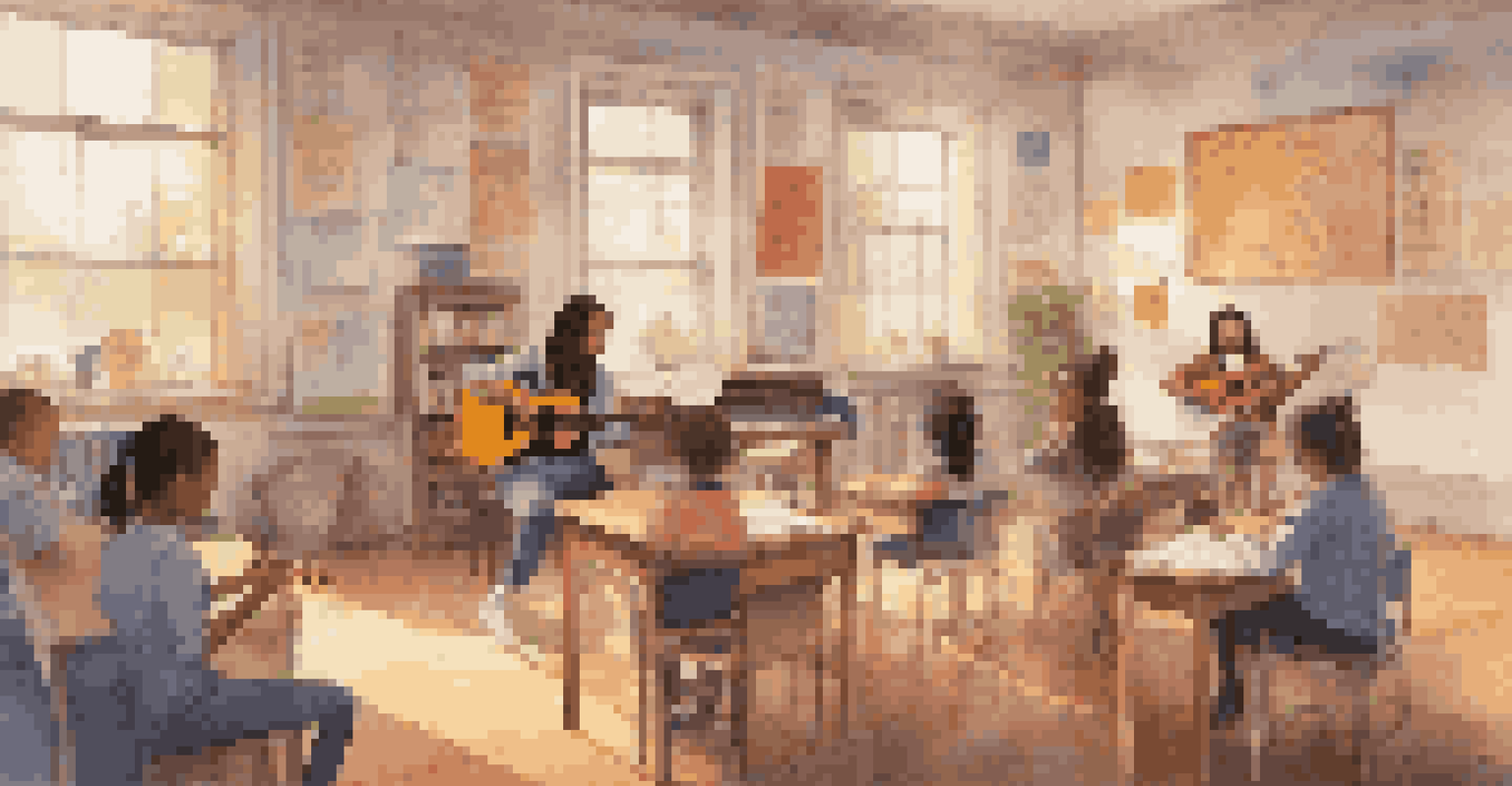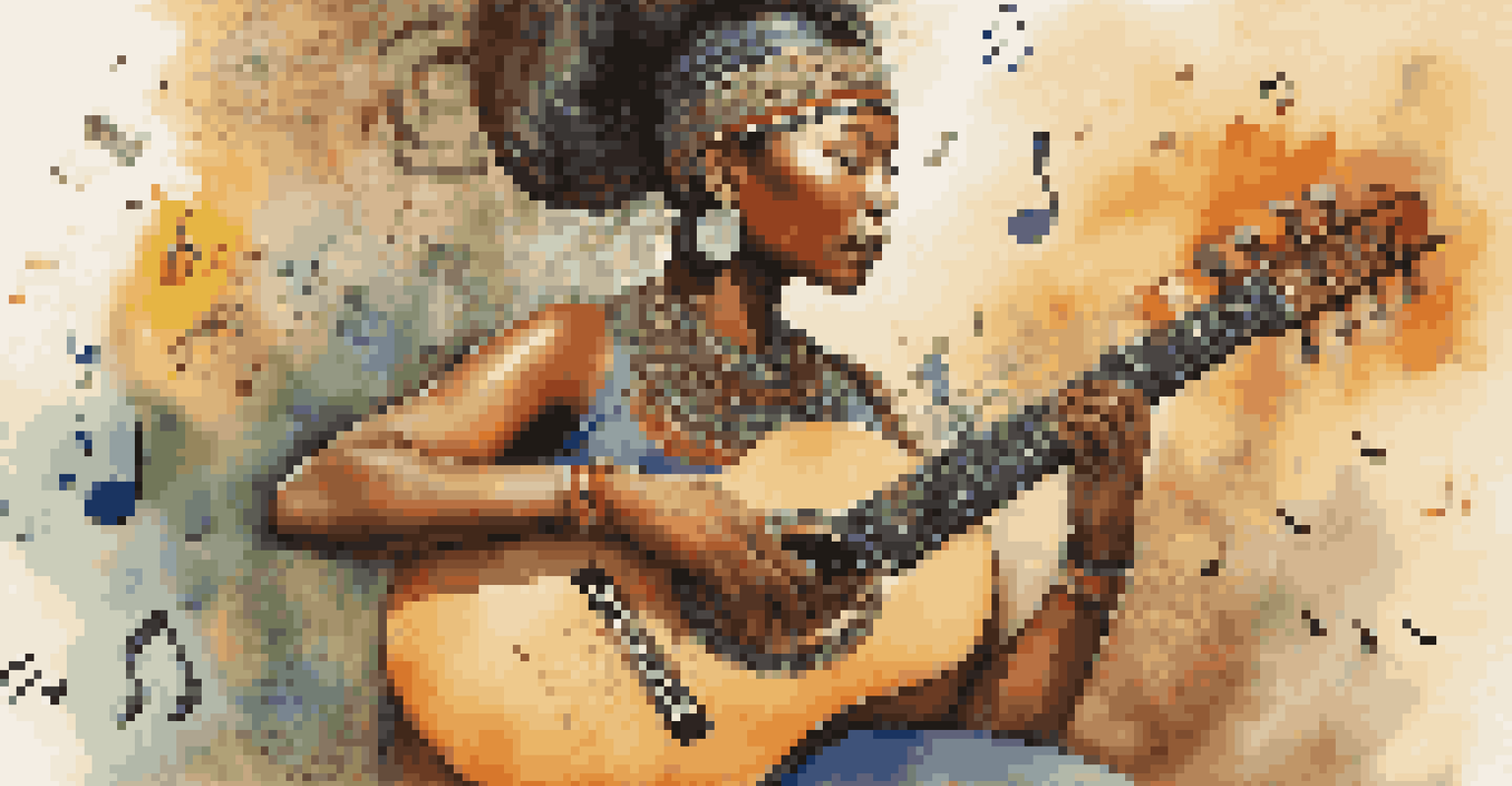Gender and the Impact of Cultural Background on Music

Understanding Gender in Music: A Cultural Lens
Gender plays a significant role in how music is created, performed, and received. Different cultures have distinct expectations and norms regarding gender roles, which often influence musical expression. For instance, in some cultures, male musicians may dominate certain genres, while in others, female voices are celebrated and revered.
Music is a powerful tool for cultural expression and social change.
These cultural norms can create barriers for artists, shaping their opportunities and the reception of their work. Women in many societies might find it challenging to break into traditionally male-dominated genres like rock or hip-hop. Conversely, in other cultural contexts, women may lead the spotlight, as seen in genres that celebrate femininity, such as pop or folk.
Ultimately, understanding these dynamics enriches our appreciation of music as a reflection of societal values. By examining how gender interacts with cultural background, we can gain insight into the broader conversations surrounding identity and expression in the music world.
Cultural Background: Shaping Musical Genres and Styles
Cultural background significantly influences the genres and styles individuals gravitate towards. For instance, traditional African music often incorporates communal singing and rhythm, reflecting the cultural value placed on community. In contrast, Western classical music might emphasize individual artistry and technical skill, revealing different cultural priorities.

This divergence can lead to varied interpretations of music and performance styles. A musician from a collectivist culture might prioritize group harmony, while those from more individualistic societies may focus on personal expression. Understanding this helps listeners appreciate the diversity of musical traditions and the cultural significance behind them.
Gender Shapes Music Creation
Cultural expectations influence how gender affects the creation, performance, and reception of music.
Moreover, these cultural styles can blend in fascinating ways, leading to new genres. The fusion of hip-hop with traditional Indigenous sounds, for instance, creates a vibrant platform for storytelling that honors heritage while pushing musical boundaries.
The Intersection of Gender and Cultural Identity in Music
The intersection of gender and cultural identity creates a rich tapestry in the music landscape. Artists often draw from their backgrounds to express their experiences, leading to unique musical narratives. This blend can empower artists to challenge stereotypes, such as a female rapper breaking barriers in a male-dominated genre.
The arts have a way of reflecting the culture of a society, and music is no exception.
For example, artists like Shakira blend Latin pop with elements from various cultures, showcasing their multifaceted identities while engaging with global audiences. This not only broadens their appeal but also encourages dialogue about cultural representation in the music industry.
By merging personal narratives with cultural influences, musicians can craft songs that resonate deeply with listeners. This connection fosters a sense of belonging and understanding, proving that music is a powerful vehicle for expressing identity.
Gender Representation in Music: Progress and Challenges
Despite progress in gender representation in the music industry, challenges remain. Women often face obstacles in gaining recognition and equal opportunities compared to their male counterparts. This inequality is evident in festival lineups and award nominations, where female artists are frequently underrepresented.
However, movements advocating for gender equality in music have gained momentum. Initiatives like the 'Women in Music' campaign aim to elevate female voices and create a more inclusive industry. These efforts not only spotlight talented female musicians but also challenge outdated perceptions of gender roles within music.
Cultural Background Influences Genres
Cultural background plays a crucial role in determining the musical genres individuals are drawn to and how they interpret music.
As the industry evolves, it's crucial to continue advocating for equal representation. By supporting diverse voices, we can help create a music landscape that reflects the richness of our societies, ultimately benefiting everyone involved.
Cultural Influences in Music Education: Gender Perspectives
Cultural influences extend to music education, where gender biases can shape learning experiences. In some cultures, boys might be encouraged to pursue music more than girls, leading to a disparity in skill development. This can limit opportunities for many talented female musicians who may not receive the same encouragement.
Moreover, the teaching methods and curriculum can reflect these biases, often favoring male composers and artists. This not only affects who students learn about but also shapes their understanding of what it means to be a musician. Changing this narrative is essential for creating a more balanced music education system.
By incorporating diverse musical traditions and recognizing female contributors, educators can foster a more inclusive environment. This approach not only empowers all students but also enriches the music community, encouraging a broader appreciation of global music.
Music as a Tool for Cultural Expression and Gender Advocacy
Music serves as a powerful tool for cultural expression and gender advocacy. Many artists use their platforms to address social issues, including gender inequality and cultural heritage. For instance, folk singers often share stories of their communities, bridging gaps between generations and fostering understanding.
Additionally, musicians like Beyoncé and Lady Gaga leverage their fame to advocate for women's rights and LGBTQ+ issues, making their music a rallying cry for change. Their messages resonate with audiences, inspiring action beyond the music itself.
Music as a Tool for Advocacy
Artists use music to address social issues like gender inequality and cultural heritage, transforming it into a medium for activism.
Through this lens, music becomes more than entertainment; it transforms into a medium for activism. By uniting people around common causes, artists can challenge societal norms and drive conversations on gender and cultural identity.
The Future of Music: Gender, Culture, and Collaboration
As we look to the future, the collaboration between diverse genders and cultures in music is more important than ever. The blending of various influences can lead to innovative sounds and genres that reflect our global society. This cross-pollination not only enriches the music we hear but also fosters mutual respect and understanding among cultures.
Emerging artists are increasingly drawing inspiration from a wide array of cultural backgrounds, creating music that resonates with a diverse audience. This trend suggests a promising shift towards inclusivity, where multiple perspectives can coexist and thrive.

Ultimately, the future of music will likely be characterized by collaboration and diversity. By embracing and celebrating these differences, the music industry can continue to evolve, reflecting the rich tapestry of human experience.